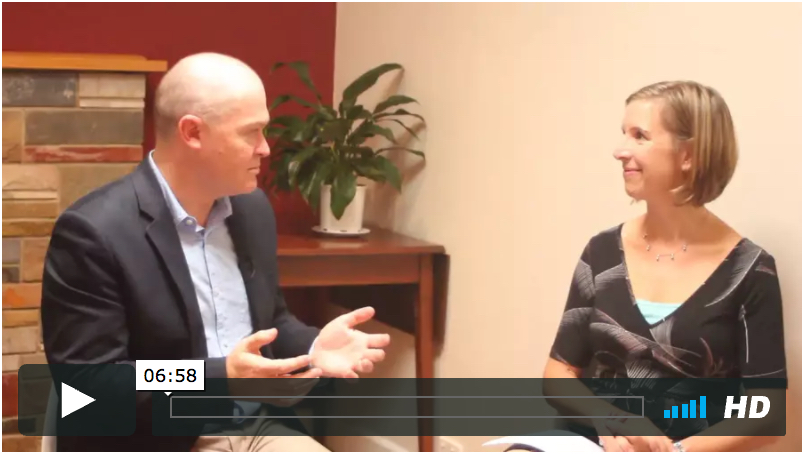Mindfulness and sleep: A doctor's perspective
Mindfulness training has been shown to help people with insomnia, and people with other types of sleep problems may also benefit.
In the video below I asked specialist sleep physician, Dr David Cunnington, about when he recommends mindfulness training to his patients and how he explains mindfulness.
Like this article?
Grab a copy of our FREE eBook - A Short Guide to Better Sleep.
Looking for more information?
You can find more information about insomnia here. And you can learn more about the influence of thinking on sleep in the related articles:
Video Transcript
David: Yeah, it’s a good question. So in terms of when I recommend mindfulness, it’s generally in conditions of sleep disorders where I think part of the core problem is the brain is too active during sleep and people can get into that situation for a whole range of different reasons. Sometimes it’s through being overly busy. Sometimes we’re exposed to external stressors and get a bit overanxious and sometimes it’s thinking styles. So a tendency to worry can increase our risk of getting into that sort of situation.
So there are a few different sleep disorders where that can happen. The one most commonly where that happens is insomnia. So insomnia is often characterised by overthinking sleep. So now it starts but that’s how it finishes. Often people really get a lot of emotion about sleep and trying very hard to control sleep and really analysing and monitoring. What can I do to make this better? So the brain is not switched off during sleep at all. It’s all about have I gone to sleep yet? Have I slept enough? What’s happening? Can I sleep some more? Can I sleep in? You know, all that style of thinking.
So training and techniques to disconnect from some of that thinking or to be able to – trying techniques to be able to switch off is really helpful in insomnia. One of the other conditions where I will use mindfulness is in managing parasomnia. So parasomnia is sleep walking or sleep talking.
So one of the triggers for them can be stress. But it can also be just with the brain in those higher adrenaline levels during sleep because essentially then, muscles are more active during sleep. So it makes people more likely to do things, act out dreams, move while they’re asleep. So one of the techniques for reducing that is actually to reduce brain adrenaline levels during sleep. So mindfulness is a great technique for that. So training people in mindfulness so that they’re able to – through the day reduce that sort of adrenaline levels and adrenaline drive and then at night-time, the brain works in a more switched off type of state so that I get the same muscle activity.
The third group where I will use mindfulness is in people who are feeling more tired during the day. It seems a bit strange. We use it if you can’t sleep. We use it if you’re too sleepy. But often when people are too tired, they’ve got an absolutely genuine biological reason why they’re tired. They may have a physical condition or a mental health condition or a sleep disorder. But over the years or months of feeling tired, the tiredness itself just gets its own story and emotion and that can add another layer to symptoms. So it’s not just I’m tired. Sometimes I’m sick of being tired. What does this mean for me? Why do I feel like this? What can I do to make it better? That style of thinking actually just gets the brain more active during sleep and makes sleep poorer quality and leads to the tiredness being worse. So we can address that layer with mindfulness. We can actually make quite a difference to people who are already feeling fatigued.
Giselle: Great. How would you explain mindfulness to someone? They might’ve heard about it before. As a doctor, how would you put it in your words?
David: Sure. So in simple terms, I try to talk about it as being present, focused observation. So one way of thinking about it, as adults, we’re often thinking about the future or the past and thinking more about judgments about our experiences which in turn lead to emotions and better experiences.
Both those judgments and emotions fit right into the adrenaline system, that sympathetic nervous system. So if they’re constantly in that thinking space that’s all about judgment and emotion, what does this mean? How do I need to respond to this? Did I do that OK? What am I going to do tomorrow?
We’re just constantly engaging that sympathetic nervous system and just higher adrenaline levels and the brain not switching off. Whereas if we’re thinking in more present and just in observation sort of mode, then we’re disconnecting that fight or flight response and not pushing up the adrenaline levels. But it’s a style of thinking that doesn’t come naturally to us, particularly as adults and particularly in modern Western societies.
One analogy I will sometimes use with patients is you think of pre-school aged children. They have that more observational thinking style, example being there are two boys in the sand pit and one bopped the other in the nose. He cries while the nose is sore. But as soon as his nose isn’t sore anymore, they’re back playing together.
Giselle: They forget it, and let it go.
David: And let it go. And really their thinking is my nose was sore. It’s no longer sore. The observation is OK, I’m not sore anymore. I will get back to playing.
Giselle: Time to move on.
David: Yeah. Whereas with adults, it’s not the same. Bloke hits the other bloke in the nose at the pub. It’s not about my nose isn’t sore anymore. It’s about what does that mean. What does that mean for our friendship? I’m angry about that. It has got that layer of judgment and emotion.
Giselle: Yeah.
David: So as adults, we’re really in that thinking space.
Giselle: Yes.
David: So mindfulness is retraining us to be able to recognise where we’re in that judgment emotion style of thinking and just reframe, recalibrate, get back to that present, focused observation and do that periodically through the day to enable us to disengage that sympathetic nervous system and that adrenaline system and just lower adrenaline levels.
Giselle: Yes. Yeah.
David: Another type of analogy we sometimes use is just to become an observer before some things around us rather than a participant in things. So that you’re on the train platform and think of your thoughts as trains that pass by. But you don’t catch them. You don’t go for the journey and you don’t sort of participate in everything that …
Giselle: Of course you have a choice about whether you catch it or not. You know if you are, yeah.
David: So that’s another analogy I will sometimes use when trying to explain mindfulness. But I think of it as a biological level and think of what I’m trying to achieve with mindfulness. It is all about disconnecting the sympathetic nervous system. So if we’re in that mode during the day or doing and the head space of thinking in the judgment and emotion style of way, we’re engaging that sympathetic nervous system, the adrenaline system, the fight-flight response and if we engage that constantly in the day, there’s no way we’re going to be able to switch it off at night.
Giselle: Yeah.
David: Whereas if we switch to that being mode which we rarely do, to stop and be, I don’t have to be doing anything, and focus our sort of thoughts on that present, focused observation, it disconnects that sympathetic nervous system and if we do that intimately throughout the day and make a practice of doing that on a regular basis, it allows the brain to be able to switch off but not – it takes a while. So it’s not the sort of thing you do for a day, right? Where are my results? You’re going to be persistent.
Giselle: It requires daily practice.
David: It does require daily practice. But that’s really – when I think about the biology, that’s how I think it works and the research would support that.
Giselle: Yes, yeah. That’s wonderful. Thank you David.
David: No worries.
Dr. David Cunnington is a specialist sleep physician who delivers quality healthcare to clients with complex sleep problems. He promotes sleep health through education, research and advocacy. David is the co-director of Melbourne Sleep Disorders Centre, a multi-disciplinary sleep clinic for the diagnosis and treatment of sleep disorders. He has also developed a fantastic website called Sleep Hub, where an answer to almost any question on sleep can be found.








